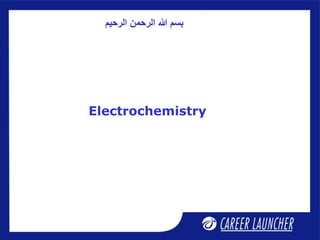
electrochemistry.ppt
- 1. الرحيم الرحمن هللا بسم Electrochemistry
- 2. Session Objectives • Conductance of electrolytic solution • Specific conductance, Equivalent conductance, Molar conductance • Kohlrausch's law
- 3. Electrolytes Substances whose aqueous solution does not conduct electricity are called non electrolytes. Examples are solutions of cane sugar, glucose, urea etc. Substances whose solution in water conducts electric current. Conduction takes place by the movement of ions. Examples are salts, acids and bases.
- 4. Types of Electrolytes Strong electrolyte are highly ionized in the solution. Examples are HCl, H2SO4, NaOH, KOH etc Weak electrolytes are only feebly ionized in the solution. Examples are H2CO3, CH3COOH, NH4OH etc
- 5. Difference between electronic & electrolytic conductors (3) Conduction increases with increase in temperature (3) Conduction decreases with increase in temperature (2) Flow of electricity is due to the movement of ions (2) Conduction is due to the flow of electron (1)Flow of electricity takes place by the decomposition of the substance. (1) Flow of electricity take place without the decomposition of substance. Electrolytic conductors Electronic conductors
- 6. Resistance refers to the opposition to the flow of current. For a conductor of uniform cross section(a) and length(l); Resistance R, a l l l R l and R R a a Where is called resistivity or specific resistance. Resistance
- 7. Conductance The reciprocal of the resistance is called conductance. It is denoted by C. C=1/R Conductors allows electric current to pass through them. Examples are metals, aqueous solution of acids, bases and salts etc. Insulators do not allow the electric current to pass through them. Examples are pure water, urea, sugar etc. Unit of conductance is ohm-1 or mho or Siemen(S)
- 8. Specific conductance 1 Specific Conductivity K a x Conductance Unit of specific conductance is ohm–1cm–1 SI Unit of specific conductance is Sm–1 where S is Siemen a But ρ = R K a.R l/a is known as cell constant Conductance of unit volume of cell is specific conductance.
- 9. Equivalent Conductance Where, k = Specific conductivity V = Volume of solution in cc. containing one gram equivalent of the electrolyte. It is the conductance of one gram equivalent of the electrolyte dissolved in V cc of the solution. Equivalent conductance is represented by Mathematically, k V 1000 k Normality
- 10. It is the conductance of a solution containing 1 mole of the electrolyte in V cc of solution. it is represented as m. Molar conductance Where V = volume solution in cc m Molar conductance k = Specific conductance M=molarity of the solution. = k × V m =k x 1000/M
- 11. Effect of Dilution on Conductivity Specific conductivity decreases on dilution. Equivalent and molar conductance both increase with dilution and reaches a maximum value. The conductance of all electrolytes increases with temperature. concentration, (mole L ) –1 1/2 CH COOH (weak electrolyte) 3 KCl (strong electrolyte)
- 12. Relation between equivalent conductivity and molar conductivity μ = valency factor(or n - factor)×λ i.e. Molar conductivity = n- factor x equivalent conductivity
- 13. Illustrative Example The resistance of 0.01N NaCl solution at 250C is 200 ohm. Cell constant of conductivity cell is unity. Calculate the equivalent conductance and molar conductance of the solution. Solution: Conductance of the cell=1/resistance =1/200 =0.005 S. Specific conductance=conductance x cell constant =0.005 x 1 =0.005 S cm-1
- 14. Solution Cont. Equivalent Conductance = Specific conductance x (1000/N) = 0.005 x 1000/0.01 = 500 ohm-1cm2eq-1 Molar Conductivity = Equivalent conductivity x n-factor = 500 x 1 = 500 ohm-1mol-1cm2
- 15. Kohlrausch’s Law a c Where are known as ionic conductance of anion and cation at infinite dilution respectively. a c and “Limiting molar conductivity of an electrolyte can be represented as the sum of the individual contributions of the anion and cation of the electrolyte.”
- 16. Application of Kohlrausch’s law (2). For obtaining the equivalent conductivities of weak electrolytes at infinite dilution. (1). It is used for determination of degree of dissociation of a weak electrolyte. v Where, v represents equivalent conductivity at infinite dilution. represents equivalent conductivity at dilution v.
- 17. Illustrative Example A decinormal solution of NaCl has specific conductivity equal to 0.0092.If ionic conductance of Na+ and Cl– ions are 43.0 and 65.0 ohm–1 respectively. Calculate the degree of dissociation of NaCl solution. Equivalent conductance of NaCl 1000 Sp.conductivity v N .0092 10000 –1 92 ohm 43 65 108 – Na Cl 92 v 0.85 108 Solution: Normality=0.10 N
- 18. Equivalent conductance of NaCl, HCl and C2H5COONa at infinite dilution are 126.45, 426.16 and 91 ohm–1 cm2 respectively.Calculate the equivalent conductance of C2H5COOH. 2 5 2 5 C H COOH C H COONa HCl NaCl = 91 + 426.16 – 126.45 = 390.71 ohm–1 cm2 Solution: Illustrative Example
- 19. Illustrative Example Calculate (a) the degree of dissociation and (b) the dissociation constant of 0.01M CH3COOH solution; given the conductance of CH3COOH is 1.65 ×10–4 S cm–1 and (CH3COOH) = 390.6 S cm2 mol–1 o m c m K 1000 Molarity Solution : 4 c 2 1 m 1.65 10 1000 16.5 Scm mol 0.01 c m o m 16.5 0.042 390
- 20. Solution 2 a c K 1 2 0.01 0.042 1 0.042 = 1.84 ×10–5
- 21. Thank you